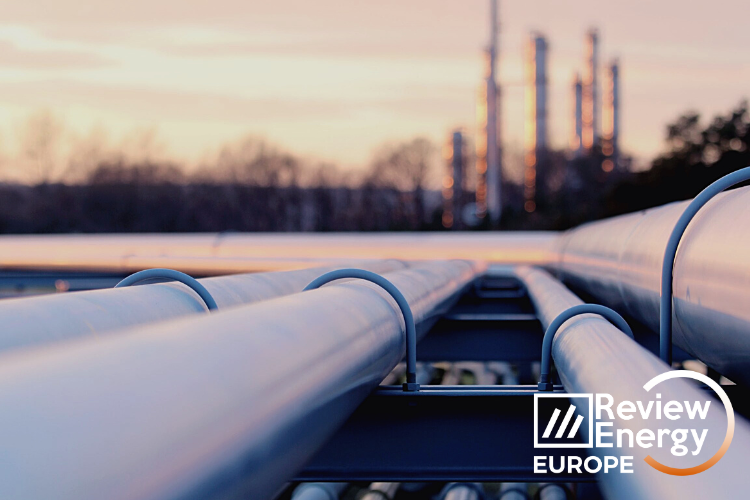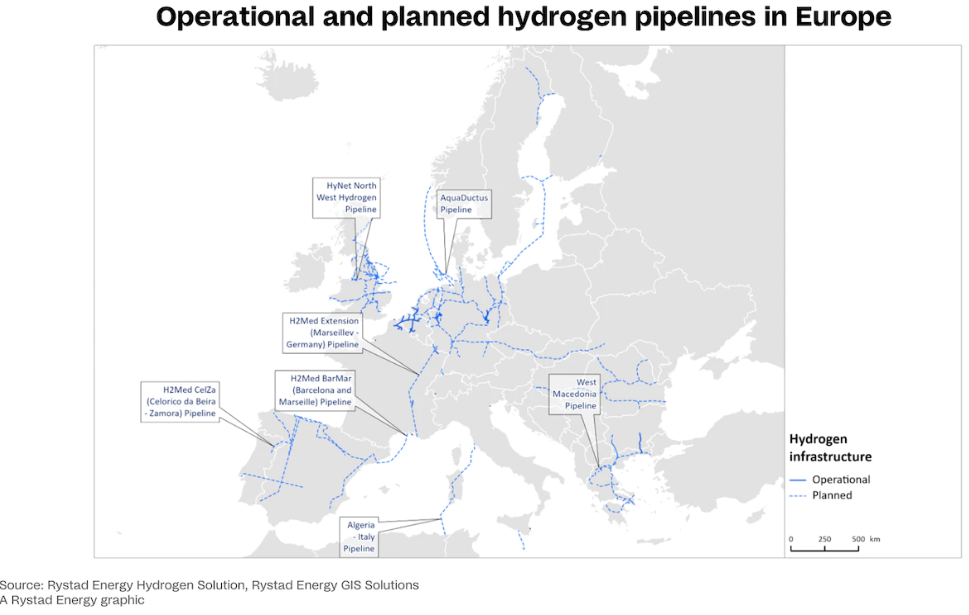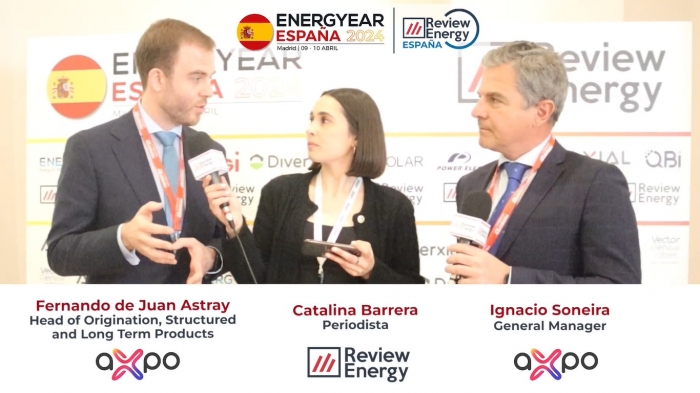
Europe takes the lead in hydrogen pipeline development
New research by Rystad Energy shows that new hydrogen infrastructure is starting to materialize as the world seeks to accelerate its path to net zero. There are very few shortcuts to a sustainable future and simply switching existing oil and gas infrastructure to hydrogen is not always viable. At the heart of this challenge is physics, hydrogen has a high gravimetric energy density and a low volumetric energy density. This means that among options, hydrogen pipelines will be far better than vessels at moving hydrogen over short to medium range distances.
Today, over 4,300 kilometers already exists for hydrogen transportation with over 90% located in Europe and North America. Rystad Energy estimates that there are about 91 planned pipeline projects in the world, totaling 30,300 kilometers and due to come online by around 2035.
In cases where hydrogen will be shipped (as hydrogen or its derivatives), it will eventually be distributed on land using hydrogen pipelines, which makes transport via pipelines a critical transportation mode for the gas. Hydrogen pipelines are already used to supply industrial hubs (at petrochemical plants for example). As supply scales up and moves from areas with abundant and renewable energy to demand centers, long transmission lines will be a necessity and these pipelines would require larger diameters and higher pressure for cost effectiveness and consequently higher steel grades.
Globally, Europe is at the forefront of efforts to produce and import green hydrogen and its attention is now turning to building the necessary infrastructure to get it to demand centers. According to Rystad Energy research, Spain, France, and Germany are among the countries committed or considering cross border pipelines to facilitate energy flows, while the UK with its extensive gas grid finds itself in a fantastic position to switch from natural gas to hydrogen.

“The steady increase in pipeline projects for hydrogen is an early sign that the energy transition is gathering pace. Europe, with its extensive gas grid is well placed to make the jump. Switching infrastructure from gas to hydrogen is possible and cost effective. But the greatest barrier is not financial, but the physical properties of hydrogen itself which differ substantially from oil and gas”, says Lein Mann Bergsmark, senior analyst, hydrogen.
Europe’s hydrogen pipeline network will knit the region together
Hydrogen is a key pillar in the EU’s decarbonization as laid out in its hydrogen strategy in 2020, and its deployment received a boost with the ‘Fit for 55’ package. It also plays a central role in the REPowerEU Plan to phase out Russian fossil fuel imports – which aims to produce 10 million tonnes of renewable hydrogen by 2030 and import another 10 Mt in the same time frame.
“Considering proposed green hydrogen projects in the EU, we are currently at 7.9 Mt of local supply with startup by 2030 (or only 2.1 Mt from target), with nearby supply amounting to 1 Mt in the rest of Europe – primarily UK and Norway – and another 1 Mt in the Middle East. Additionally, 3.4 Mt of proposed projects are in Africa, which could supply the largest amounts of hydrogen to Europe – by ship or pipeline2, says Rystad Enegrgy.
To plan for the distribution of these within the bloc, the European hydrogen backbone (EHB) initiative, which is a group of 31 European gas transmission system operators (TSOs), has published a vision paper for the future hydrogen pipeline infrastructure. This is based on national analysis of availability of existing natural gas infrastructure, future natural gas market developments, and future hydrogen market developments.
According to the EHB’s 2030 hydrogen infrastructure map, a total length of ~28,000 km in 2030 and 53,000 km by 2040 is envisioned in the 28 European countries involved. Currently, dedicated hydrogen pipelines that will be available by 2030 amount to 23,365 km, which is 83% of 2030 target. Rollout of hydrogen pipelines in Europe would be gradual and the project start of transmission or distribution pipelines will depend on the demand.
Top 3: France, Spain, and Germany
Europe is taking the lead globally with pipelines planned on and offshore, says the new research. The recently announced H2Med Barcelona-Marseille subsea hydrogen pipeline is budgeted to cost around $2.1 billion for a stretch of 450 km and it was recently announced that it will be extended to Germany too. Four grid operators – Spain’s Enagas, Portugal’s REN, and French pair GRT and Terega – are currently conducting technical studies, potential pipeline layouts and cost assessments.
Germany’s first offshore hydrogen pipeline project, AquaDuctus, will transport green hydrogen from offshore wind installations in the North Sea to Germany. The pipeline stretches over 400 km and according to one of its project partners, RWE, is said to be the most cost-effective option for transporting large volumes of energy over distances of more than 400 kilometers, compared to transporting power from a High Voltage Direct Current (HVDC) transmission system. For this reason, the option to transport power onshore using power cables is excluded.
Greece
The West Macedonia pipeline is a new natural gas pipeline that started construction in Greece earlier this year. It was designed to be capable to safely carry 100% hydrogen at a later stage at high-pressure through high-strength steel pipelines with large diameters. Greek gas transmission system operator DESFA will operate this 163-km pipeline, which is part of the EHB initiative.
The construction of new dedicated hydrogen pipelines will be complemented with repurposing of existing gas networks. According to the EHB, 60% could be repurposed by 2040, while according to pipeline projects in the works, this currently accounts for 40%.
Rystad Energy explains new build pipelines will be needed but may face a range of hurdles concerning traffic movements, construction management and environmental protection, especially if it stretches long distances and goes through residential areas.
For example, Cadent’s new 125 km HyNet North West pipeline in the UK could hinder the development of the project. HyNet will produce, store, and distribute hydrogen, in addition to capture and store carbon from industry in the Northwest. The pipeline, which could be UK’s first 100% hydrogen pipeline at scale, is set to distribute hydrogen produced at Stanlow Manufacturing Complex to several industrial gas customers across the region. However, the regulatory model for hydrogen pipelines in the country hasn’t been agreed upon yet, and Warrington Council, one of the local authorities on the pipeline’s route, claimed it would disrupt a local housing development.

Repurposing of pipelines offers a compelling alternative from an economic perspective, and can be fast-tracked too, compared with laying down new pipelines. Europe has an extensive gas grid and repurposing this for hydrogen as gas declines will breathe life into a system that might otherwise have gone to rust. After modifications, repurposed steel natural gas pipelines can accommodate 100% hydrogen gas. However, when hydrogen is blended with gas, the percentage is restricted to about 20% where its end-use purpose is direct or indirect heating.








Comentarios
Sé el primero en comentar...